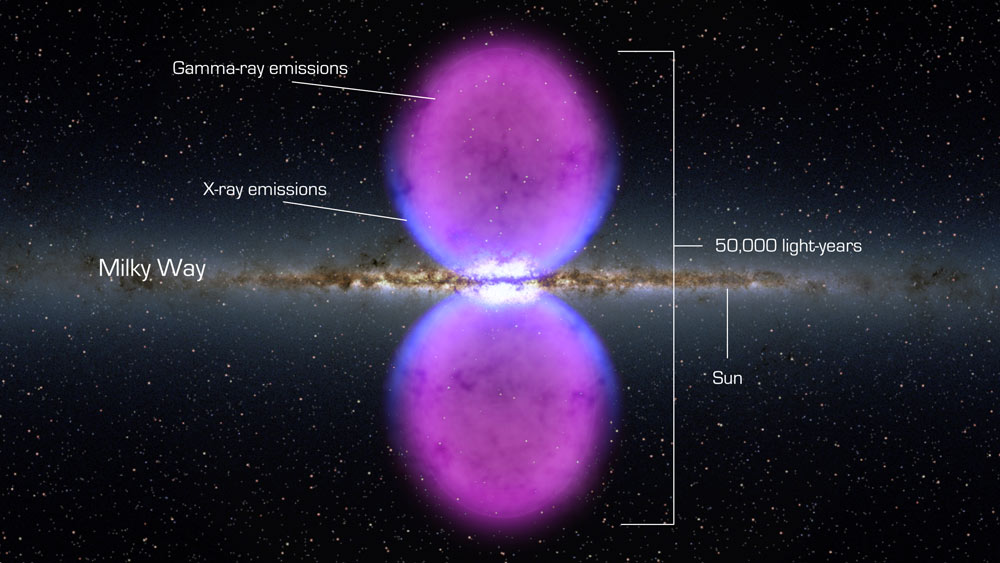
Scientists have detected two gigantic bubbles of high-energyradiation spilling out from the Milky Way's center that may have erupted from asupermassive black hole.
The mysteriousstructures each span 25,000 light-years across, meaning that together they cover more than half the area of the visible sky, and are emitting gammarays, the highest-energy wavelength of light.
The bulbous features may be evidence of a burst of starformation a few million years ago, researchers said. Or they may have beenproduced when a supermassive black hole in the center of our galaxy gobbled upa bunch of gas and dust.
The newly discovered structures remain an enigma for now, scientistssaid. [New photo of gamma-ray bubbles]
"We don't fully understand their nature ororigin," said study leader Doug Finkbeiner of the Harvard-SmithsonianCenter for Astrophysics.
Scanning the gamma ray sky
Finkbeiner and his team used observations from NASA's FermiGamma-ray Space Telescope, which maps the sky's gamma-raylight. The scientists processed data from Fermi's Large Area Telescope, thehighest-resolution gamma-ray detector ever launched.
Get the Space.com Newsletter
Breaking space news, the latest updates on rocket launches, skywatching events and more!
By filtering out the fog of background gamma rays suffusingthe sky, the researchers were able to pick out the huge bubbles. The scientistsweren't flying blind; previous studies by other astronomers using otherinstruments had found intriguing clues that a huge, previously unknownstructure might be lurking near the Milky Way's heart.
X-ray observations from the German-led Roentgen satellite,for example, provided hints of bubble edges close to the galactic center. AndNASA's Wilkinson Microwave Anisotropy Probe detected an excess of radio signalsat the position of the gamma-ray bubbles, researchers said.
"We were definitely looking for something,"Finkbeiner told reporters today (Nov. 9). "Some hints of this signal hadbeen seen before, but not convincingly."
The two bubbles are dramatic, enigmatic and huge. They'reemitting about the same amount of energy as 100,000 exploding stars, or supernovae,Finkbeiner said.
The bubbles' combined width of 50,000 light-years is abouthalf of the entire Milky Way's diameter. The structures extend as far as the distance between oursolar system and the galaxy's core (the bubbles don't envelop Earth; theyspread out in a different plane).
A paper about the findings will be published in an upcomingissue of The Astrophysical Journal.
Possible causes
Researchers aren't yet sure what created the bubbles. But the structures appearto have sharp, well-defined edges, suggesting they were formed by a large,rapid and relatively recent release of energy.
Two leading candidate causes, according to Finkbeiner, are asurge of star formation several million years ago and a burst of activity bythe Milky Way's central black hole, which is as massive as four million suns.
Astronomers have observed powerfuljets blasting from the supermassiveblack holes in other galaxies. These jets are fueled by matter falling intothe black hole.
"These monsters, once fed, can produce very powerfulexplosions," said David Spergel, chair of Princeton University's astrophysics department.
While there is no evidence the Milky Way's black hole hassuch jets today, it may have in the past, researchers said.
"This might be the first evidence for an outburst of activityof the black hole at the center of the galaxy," Finkbeiner said.
Scientists are now conducting more analyses to get a betterhandle on just what drives the newly discovered bubbles, and what they canreveal about the nature of the Milky Way and the universe.?
"Whatever the energy source behind these huge bubbles may be, it isconnected to many deep questions in astrophysics," Spergel said.
- Video: Giant Gamma-ray Bubbles Found Around Milky Way
- The Strangest Things in Space
- Top 10 Star Mysteries
Join our Space Forums to keep talking space on the latest missions, night sky and more! And if you have a news tip, correction or comment, let us know at: community@space.com.

Michael Wall is a Senior Space Writer with Space.com and joined the team in 2010. He primarily covers exoplanets, spaceflight and military space, but has been known to dabble in the space art beat. His book about the search for alien life, "Out There," was published on Nov. 13, 2018. Before becoming a science writer, Michael worked as a herpetologist and wildlife biologist. He has a Ph.D. in evolutionary biology from the University of Sydney, Australia, a bachelor's degree from the University of Arizona, and a graduate certificate in science writing from the University of California, Santa Cruz. To find out what his latest project is, you can follow Michael on Twitter.








